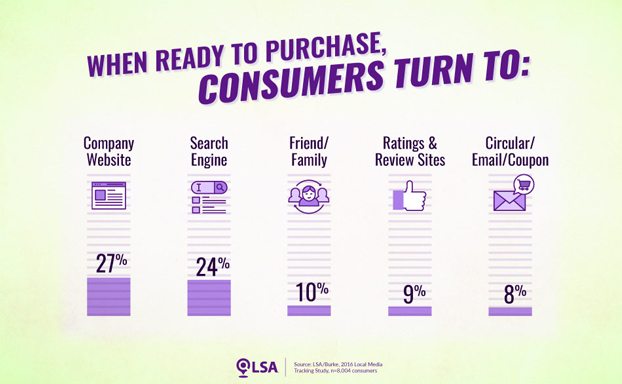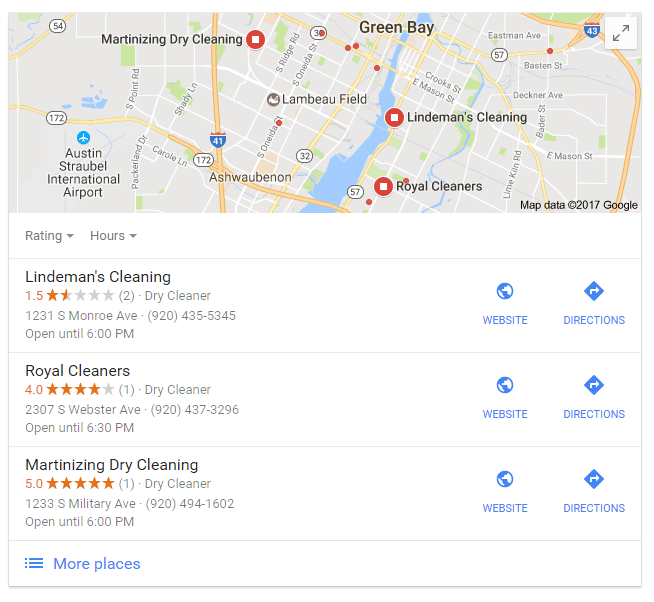When Consumers Are Ready to Buy, They Search

Today, we search for everything. Google is a common verb—so common that we “Google” more than 3.5 billion queries each day.
What does this mean for marketers?
Consumers enter the conversion funnel (which is less like a funnel and more like a swirling, nebulous cloud full of social media, Google searches, reviews, and ads) at various points. No pretty, organized conversion path exists. Rather, customers pass through phases of awareness and consideration on their way to finally making a purchase decision. And, customers (or potential customers) search online every step of the way.
Intuitively, we know that customers search online for our products and services—we do it as well. People search to get ideas, learn what products and services they may need, figure out benefits of one product over another, explore options, compare prices, and anything else that may relate to eventually making a purchase. But do we realize that customers also turn to Google when they’re ready to buy?
When consumers are ready to buy, they search.
Why search when ready to buy? Why not just open Amazon and get a drone to drop off your purchase at your door the next day?
Check out the following infographic from Local Search Association (LSA):

According to LSA, 72% of consumers turn to digital channels when they are ready to buy. As shown, 24% of people turn to search engines specifically when ready to make a purchase. Indirectly inferred in this graphic, however, is that many who stated that they turn to the company website, ratings and review sites, etc. arrive at those sites through a search engine.
When consumers are ready to buy, they search for ratings, reviews, and for numerous other reasons:
Previous searches did not include specific purchase information
As shown above, one large reason consumers search when ready to buy is to find an actual website to visit. Consumers likely visited blogs, review sites, Facebook and other social media, and other non-commercial channels to learn what they needed. Now they’re ready to purchase and need to compare prices, check availability, and find the right place to patron.
Consumers know what store or business they want, now they need to know how to get there
More than half of local mobile searches seek an address, phone number, or directions to a business. Particularly when on the go, people search for the necessary businesses near them and how to get there.
The product or service is not available online
Amazon is great, but it doesn’t have everything. Additionally, most services must be purchased or used in-store (like dental work and car repair) or require some sort of conversation and further specifics (like landscaping and construction contracting). After all the research, consumers must still search for a specific business and interact with that business in person or on the phone.
Awareness and consideration interactions happened across many different mediums
Consumers come in contact with products and services in many different ways. Even when purposefully researching a product or service, a person could use their phone, tablet, work desktop, home computer, and spouse’s device. When a consumer is ready to purchase, all of the research done so far is not accessible in one place, and he or she must start their search anew, this time with the specific intent to buy.
Consumers already know what they want and skip straight to purchasing
Sometimes consumers already know what they want without having researched or discussed with anyone. They know what products or services they like and have used in the past and simply need to search for the right place to make the purchase.
The purchase decision was triggered offline
A word from a friend, an ad on a passing bus, or a real-time emergency or need might trigger a purchase decision, and the consumer then searches for the product or service with the express intent to buy.
Consumers are mostly decided and need some last-minute information
Often, consumers know what they want but need to find some last-minute information to confirm their decision before purchasing. For example, people often check reviews and ratings of a product, service, or business to confirm they made the right decision–even if they’ve researched ratings in the past.
What does this mean for business?
Consumers’ searching with the intent to buy has some interesting implications. Consumers likely already know about your products or services, even if they have not yet visited your website or seen your marketing material. They know what the machine does, how the shoes are rated, and they know what people think about your repair services.
Hopefully they got some of that information from you. Ideally, your inbound marketing efforts are effective, and you have been able to influence consumers earlier in their journey. Perhaps you have a great how-to blog. Maybe you explain technical details more clearly than anyone else. Or, perhaps your social media content is amazing. Best-case scenario, customers go straight to you when they’re ready to buy, without even needing to search.
But that’s a best-case scenario, and you need to get in front of as many potential customers as possible. Your website needs to pop up when people are searching to buy. You need to have a solid local SEO campaign.
The click-through rates of Google search engine results pages (SERPs) are quite compelling. Almost one third of all searchers choose the first search result, and 50% choose one of the top three results. The click-through rate drops off significantly from there. Therefore, doing everything you can to show up toward the top of page one in the SERPs is extremely important.
Local SEO
Local search statistics are even more compelling. More than 75% of local searchers visit the store within 24 hours of searching, and almost 80% of local, mobile searches result in an offline purchase.
For local businesses, local search and local SEO are the key to showing up in front of more people. Getting in front of more people means getting more customers through the door who are making purchases. Local SEO strategies can push you toward the top of the SERP and put your business in multiple places on the SERP: in local packs, traditional organic results, and business directories. Organic results are self-explanatory, and we discuss local packs and business directories below.
Local Packs
The majority of local searches feature local packs, such as the one shown below for “cleaners in green bay.” Local packs highlight three local businesses, display ratings and business information, and contain maps. Landing a place in a local pack is invaluable and is dependent on your SEO strategy and your reputation–both online and offline.

Business directories
Results for business directory listings are mixed in with “regular” business results in organic listings below the local pack. Business directories are sites such as Yelp, Tripadvisor, and Yellow Pages. These sites serve as directories for local businesses within various industries and categories. Often, the more helpful features of business directories are reviews and ratings from past customers. If your business is listed in multiple directories, you have the opportunity to show up on local SERPs multiple times.
When consumers are ready to buy, they search. And your website needs to show up quickly when they do. People search for a host of different reasons, and a comprehensive local SEO strategy is the only way to ensure your website not only shows up in the SERPs but shows up multiple times: in local packs, traditional organic results, and business directories.
Contact Boostability today for a free website and SEO analysis. Let us handle your local search strategy so you can focus on your business!
